Artists
Why Louisa Gagliardi’s Luminous Canvases Are Captivating Collectors
The Swiss artist makes medium-bending paintings that reflect our chronically online age.
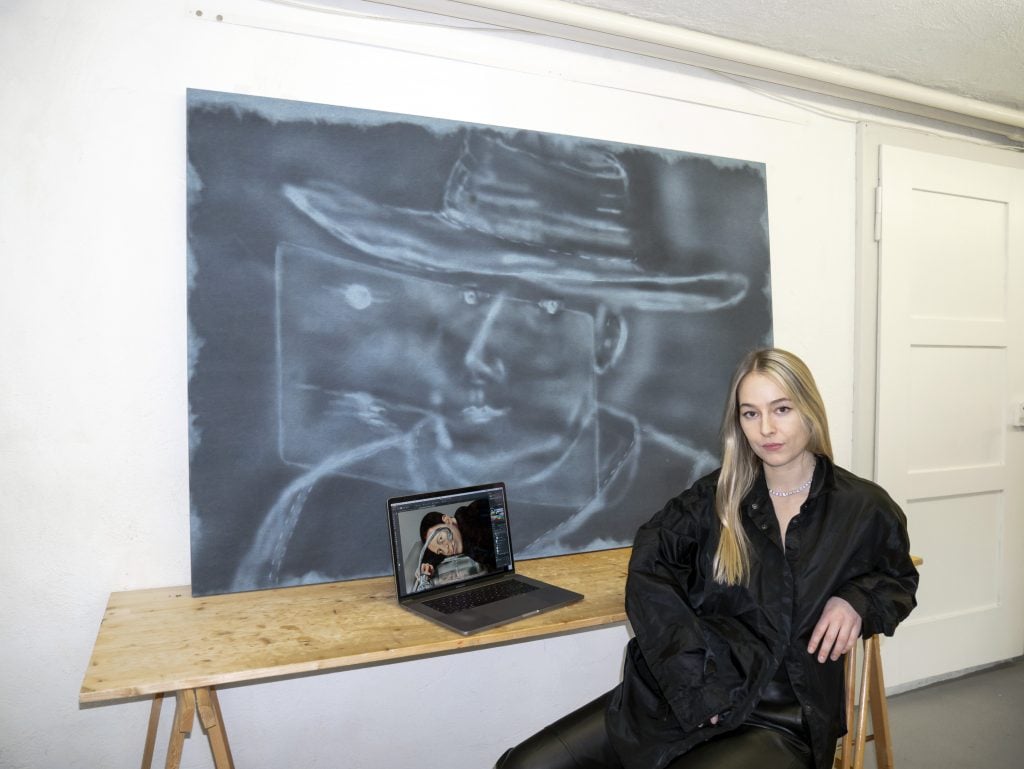
The Swiss artist makes medium-bending paintings that reflect our chronically online age.

Katie White

“I forget I even have a body,” artist Louisa Gagliardi said with a wry laugh. “Working becomes a mental marathon.”
The Swiss painter was putting the finishing touch on new works headed to two group shows in Zurich during our video call. In “There I lost myself, I lost myself” at Blue Velvet Projects (through July 27), a pair of pristine interiors mirror one another in a large painting called Visitor, where two figures, one on each panel, engage in self-care rituals. Superimposed on the work, hovering above them, is a painted chain door guard.
“Our generation of people have this feeling of being hyperconnected via technology and social media but are feeling more and more isolated,” she told me. “It’s the central recurrent theme in my work.” Her slick figurative paintings navigate the anxious dichotomy between our online and IRL existences—tensions the artist admits she’s not immune to, especially when deadlines loom.
In spite of the calm spa-like scenes in Visitor, for example, there is a sense of slight unease, a feeling that “either something just happened or is about to happen,” noted the artist. “We are too late or too early.”
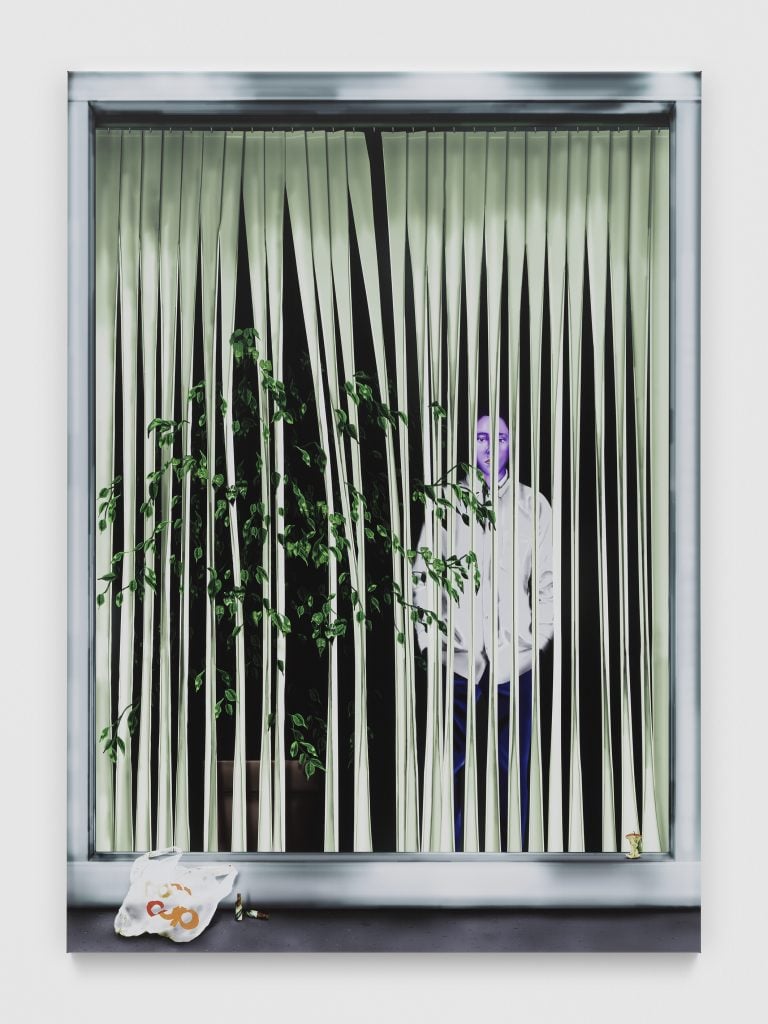
Louisa Gagliardi, Hardly Working (2024. Courtesy of the artist and Galerie Eva Presenhuber, Zurich / Vienna © the artist Photo: Stefan Altenburger Photography, Zürich.
An Alien Luminescence
Over the past several years, these uncanny paintings have earned Gagliardi the attention of collectors and critics alike. Her exhibition schedule has been rigorous and her studio days long. Earlier this spring, she opened “Hard Feelings” a solo show with Galerie Eva Presenhuber, one of her representing galleries, in Seoul, South Korea. Her works were also the subject of a solo institutional show called “Deep Breaths” at CC Strombeek in Belgium earlier this year. These followed her 2023 solo debut with Presenhuber in “A Moment’s Notice” and “Reasonable Doubt” a 2022 solo exhibition with Dawid Radziszewski in Warsaw, Poland. She’s already starting to gear up for her next exhibition with Presenhuber, the dates of which have yet to be announced.
Her back-to-back exhibition calendar is a testament to her paintings’ strange, almost sci-fi allure. Figures (she calls them “avatars”) occupy her uncanny, airtight tableaux, staring off listlessly into space—Degas’s L’Absinthe comes to mind. But is this absence ennui or unreality? In certain works, these avatars are translucent—spectral beings with alien luminescence. Sensual, strange, and suggestively lit, Gagliardi’s paintings are meant to hypnotize. Their surfaces are unnaturally smooth—but, one senses, something is going on beneath the surface.
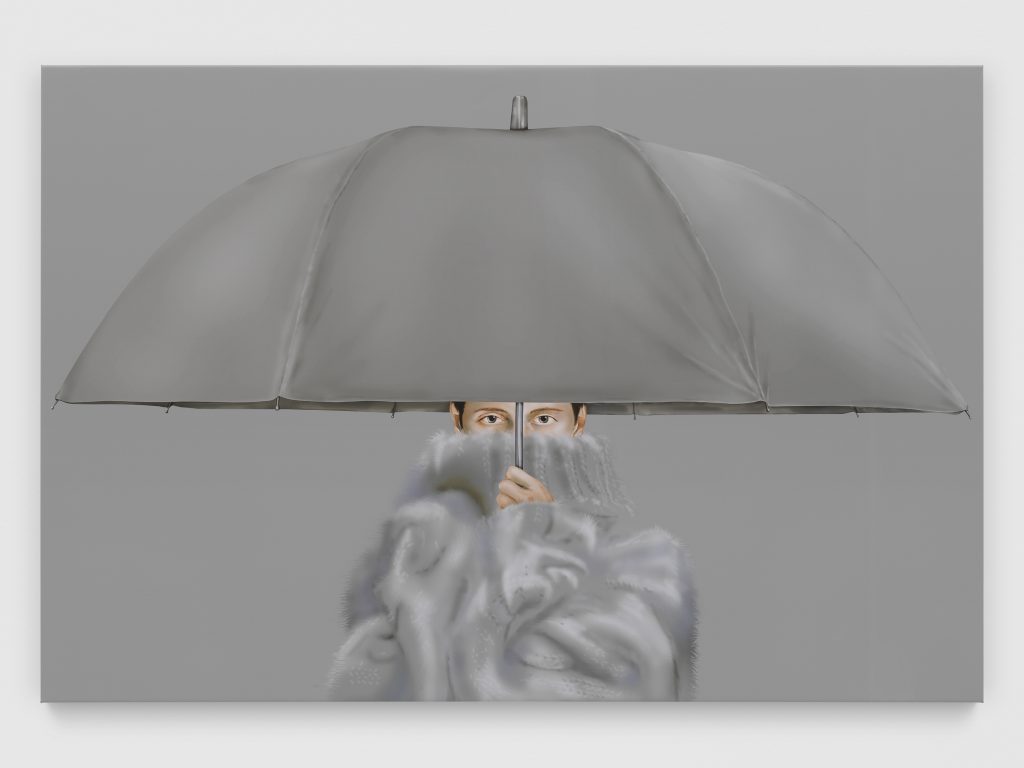
Louisa Gagliardi, Greyout (2024). Courtesy of the artist and Galerie Eva Presenhuber, Zurich / Vienna © the artist Photo: Stefan Altenburger Photography, Zürich
These paintings aren’t paintings in a traditional sense, that’s for sure. Gagliardi doesn’t bring a brush to canvas. Instead, she translates sketches (drawn by hand or digitally) through numerous digital imaging processes, editing her forms and colors until she achieves her signature cinematic effect. The files are then printed with ink onto PVC surfaces, creating an image that appears ultra-flat. Often Gagliardi will add touches of clear gel or even nail polish to the works by hand, sometimes even covertly adding her signature.
“The PVC vinyl I use is glossy and plasticky and reminiscent of like the screen. My early paintings almost looked lit by the screen. It’s sexy and glossy” she explained. But the process is laborious, which the smooth veneer of her paintings belies. “Drawing and painting are my biggest pleasures and I’ve found the way that fits me,” Gagliardi said. “But my work is certainly not a click away. That’s maybe the biggest misconception.”
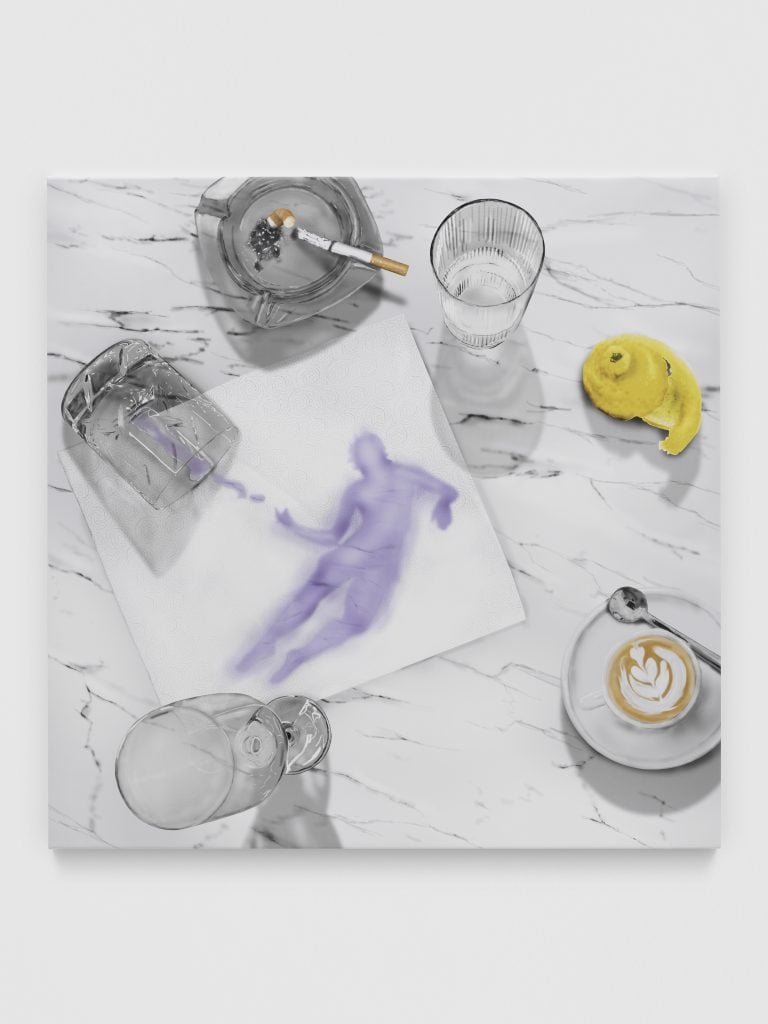
Louisa Gagliardi, After Taste (2024). Courtesy of the artist and Galerie Eva Presenhuber, Zurich / Vienna © the artist Photo: Stefan Altenburger Photography, Zürich.
This decidedly industrial technique has roots in her previous career—Gagliardi studied graphic design at Gerrit Rietveld Academie in Amsterdam and spent several years working in the commercial world, often collaborating with fashion brands. “During my studies, I gravitated towards what I would call illustration,” she explained, calling her decision to work in graphic design “a pragmatic choice” but one that ultimately left her feeling creatively stifled.
She pivoted to painting in the early 2010s, kicking off her quick ascent through the art world. The earliest audience for her work was built online, through Instagram, Tumblr, and her website.
“’Let’s try something else,’ I thought. I did a series of three portraits, which I freehanded in Photoshop. There was no goal. I was not doing it for anyone,” she recalled. “I put these three JPEGs on my website and within two weeks I had two galleries asking me to show the work.”
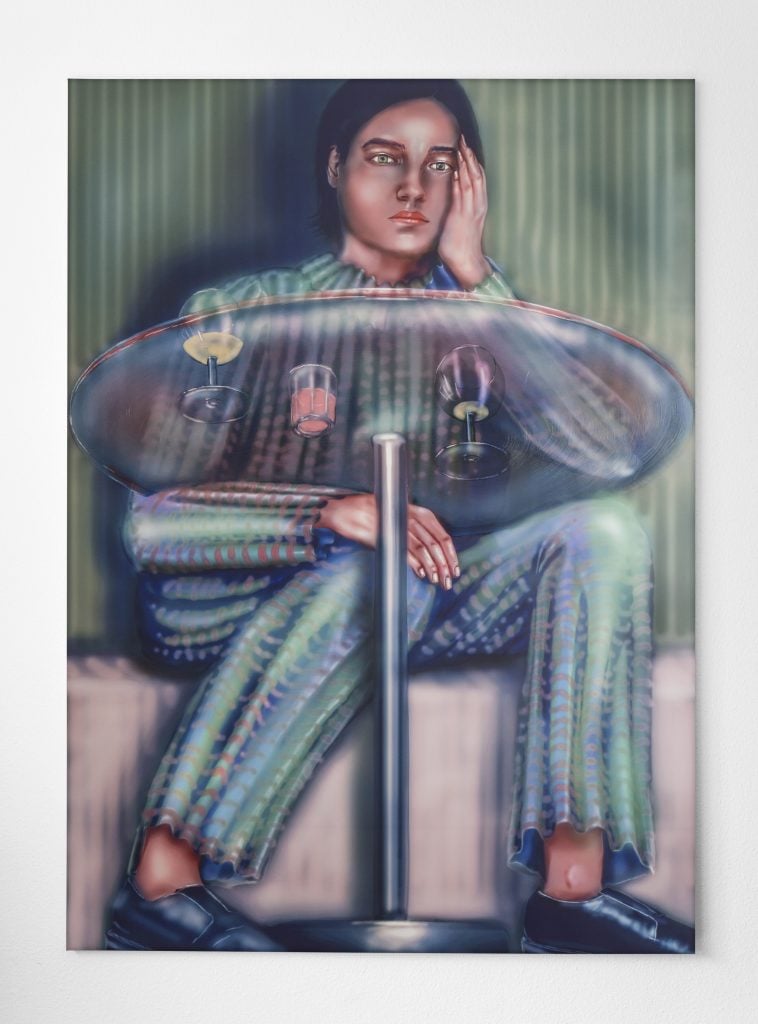
Louisa Gagliardi Absent-minded (2020). Courtesy Dawid Radziszewski Gallery.
Interest in her work was as immediate as it was global; in the late 2010s she showed with trendsetting galleries, including Tomorrow Gallery and Zach Feuer Gallery, both in New York, Plymouth Rock in Zurich, and The Cabin and Smart Objects in Los Angeles, gaining representation with Dawid Radziszewski in Warsaw, Poland, and Rudolph Janssen in Brussels.
Her first show with Eva Presenbuer was a two-artist show with Yves Scherer in 2022. By now, her works range from 20,000 to 100,000 Swiss francs ($22,300 to $115,000), according to Presenhuber. At Art Basel earlier this month, Dawid Radziszewski presented several works by the artist, ranging from 30,000 to 60,000 euros ($32,200 to $64,300. One work sold at the fair, and Radziszewski says he’s in talks about two others, adding that the works “were very well received.”
Her secondary prices have yet to take off, however, and so far only 12 works have headed to the auction block, with prices hovering around $15,000. Her 2020 work Absent–minded sold for just over $13,800 at Phillips Hong Kong this May, and a record was achieved at Phillips London in March, where her painting from 2017 sold for $17,951 with fees.
On and Off the Grid
The slippage between life online and physical space has always been Gagliardi’s main concern, but over the years of 2020 and 2021, these tensions exacerbated. “There was a fear of being in real life versus the curated or the seemingly curated version of ourselves online,” she said. “But what I’m starting to understand also is one isn’t better or worse. I kind of love these two people that I get to be in a way.” The artist has a large following on Instagram of around 19,500 followers.
“Though my anxiety does heighten in real life, I admit,” she added. “With this interview, I’d love to do it in writing so I can hyper-control what I’m going to say and sound cohesive, but the best things always happen out of chaos and unexpected moments.”
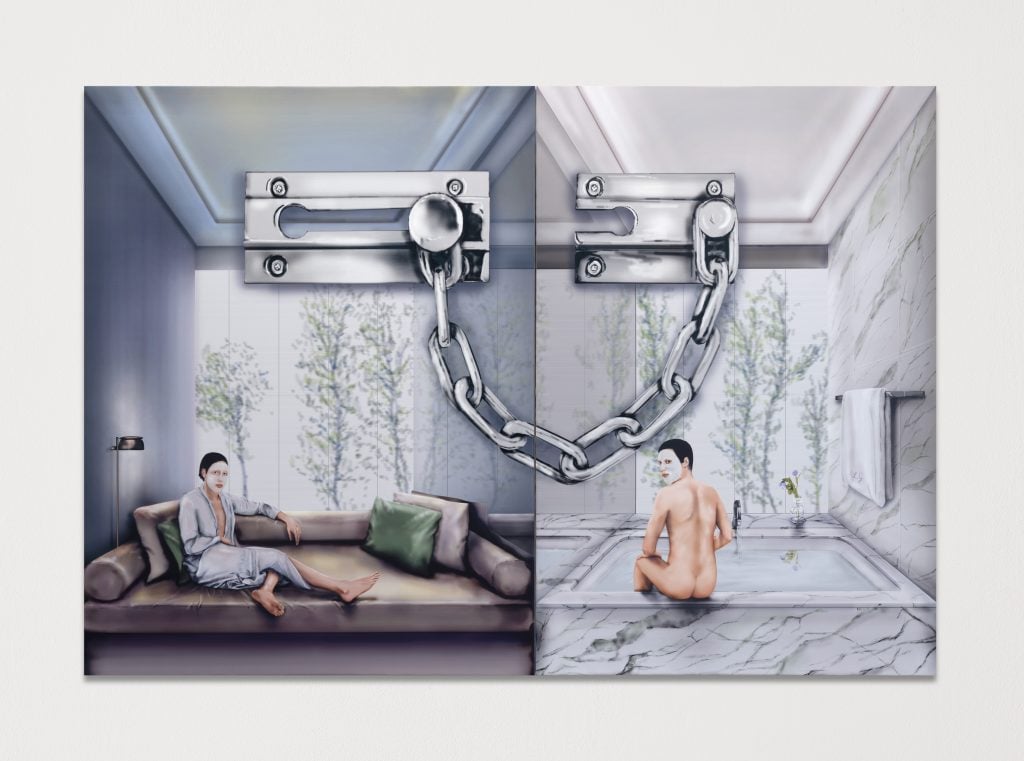
Lousia Gagliardi, Visitors (2024). Courtesy of the artist and Blue Velvet Projects.
These interior and exterior selves are at play in her works, too, presenting riddles of space that confound reality and fantasy, artist and viewer, object and idea. Reflections are everywhere in these compositions. Glasses, mirrors, and pools of water create the portal-like effect of a smartphone or a painted maze of mirrors.
Sometimes, an image can feel very removed from reality until one notices the details; in Visitor, for example, the artist’s initials, L.G. are embroidered on a towel, a hint that her presence lingers in each of these works. Gagliardi often toys with trompe l’oeil devices, a longstanding pictorial tool meant to hint at the talents of the artist. The more time one spends with Gagliardi’s work, the more rooted in art history and portraiture her works seem to become.
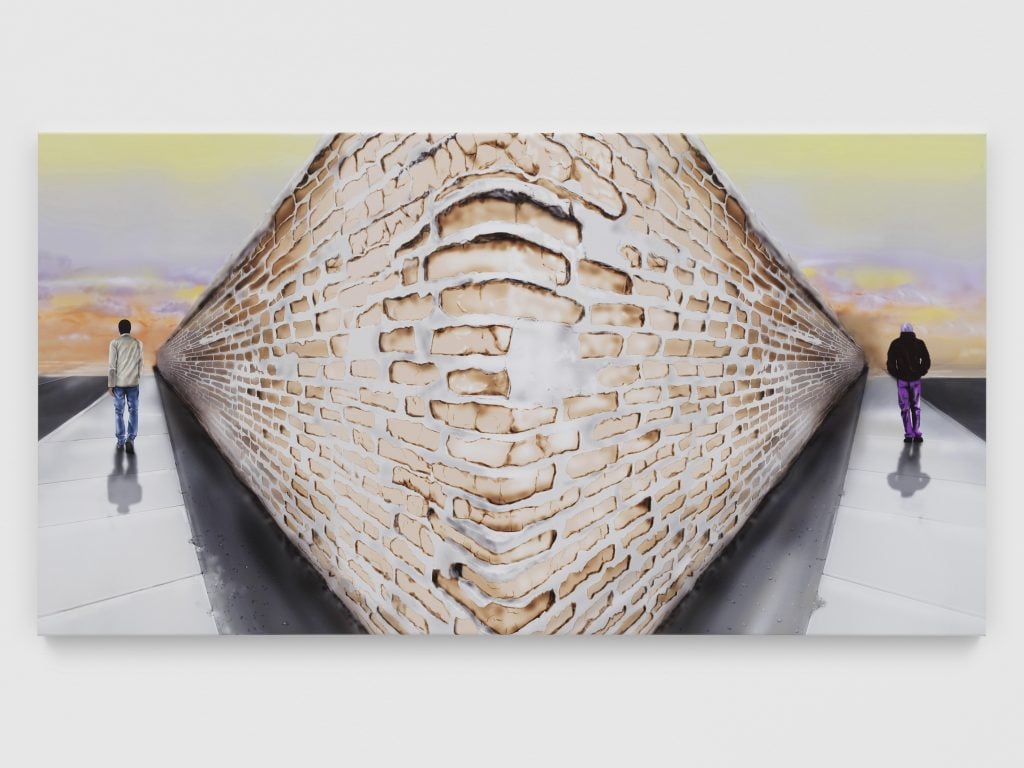
Louisa Gagliardi, Second Thoughts (2024). Courtesy of the artist and Galerie Eva Presenhuber, Zurich / Vienna © the artist Photo: Stefan Altenburger Photography, Zürich
She counts among her influences Fernand Léger, whose sculptural, almost animatronic figures are often regarded as a progenitor of Pop art—like Léger, Gagliardi also creates sculptures, objects that add complexity and playfulness to her practice. In her 2023, show “Moments Notice” the artist presented a series of bed-like sculptures made of ink on polyester. In one work, Catching Zzz, the depiction of rumpled sheets and an eye mask appear so life-like that one is tempted to reach out and make the bed.
Other influences are more unexpected. In the exhibition at Blue Velvet Projects, her works are shown alongside those of Sibylle Ruppert, a visionary 20th-century German artist who melded a bodily grotesque with a mechanical sheen. “I’m a big fan of her works. She was a contemporary of H.R. Giger and made amazing paintings and drawings,” Gagliardi said.
The otherworldliness of her paintings harkens back to Gagliardi’s very earliest encounters with art. “My godmother was an art historian. She specialized in religious painting and would take me to the museum. She’d choose two or three paintings and tell me all the little stories and meanings. It was so fascinating, mysterious, scary, and mesmerizing to me,” she said, “I’m trying to recreate that feeling in a way, an ability to project yourself into another universe. It’s a kind of lucid dreaming.”